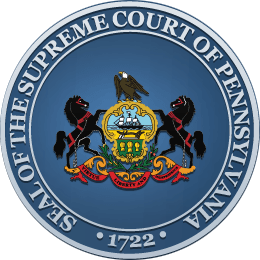News
State of the Commonwealth’s Courts’ Highlights Challenges, Solutions, and Triumphs
News Article
May 01, 2006
HARRISBURG, May 1, 2006 — Pennsylvania’s courts are strong and prepared to meet future challenges, Chief Justice of Pennsylvania Ralph J. Cappy declared today. The Chief Justice’s statement is contained in Looking to the Future: The State of the Commonwealth’s Courts, the first “state of the judiciary” report released in more than 20 years by a chief justice. Looking to the Future… was released by Cappy on behalf of his colleagues on the Supreme Court and in recognition of jurists, staff and citizen-volunteers throughout Pennsylvania’s Unified Judicial System. The 12-page booklet is designed not only to define many of the challenges facing the judiciary, but also solutions being pursued to meet those challenges by enhancing judicial administration through automation, innovation, education and intergovernmental collaboration. Several of the judiciary’s notable successes are also highlighted. “Many positive initiatives are ongoing to help make Pennsylvania’s courts more responsive, efficient, ever more fair, and always in accord with the Rule of Law,” the chief justice said. “I hope that this ‘state of the judiciary’ offers a useful snapshot of much that we are about now, and for our future.” More than 25 state court systems currently produce similar documents. Pennsylvania’s State of the Commonwealth’s Courts reflects both the hard work of the past two decades, in areas such as judicial automation, while also outlining initiatives of the past three years, including greater assurance of access to and quality of justice, led by Cappy and Justices Ronald D. Castille, Sandra Schultz Newman, Thomas G. Saylor, J. Michael Eakin, Max Baer, former Justice Russell M. Nigro, and now, newlyinstalled Justice Cynthia A. Baldwin. “Communicating about the work and values of Pennsylvania's judiciary is important so citizens can better assess the work of the Commonwealth’s third, independent branch of government,” the chief justice noted. “It is important that citizens are well informed about their court system and the direction we are taking.” Dating to 1684, Pennsylvania’s Supreme Court is believed to be the oldest court in North America. Looking to the Future: The State of the Commonwealth’s Courts offers a sense of how Pennsylvania’s more than 300-year-old court system has evolved and grown from principles established by William Penn and the Founding Fathers against a constantly changing backdrop in American culture, science and law. A limited number of copies have been printed for distribution, but a full copy of the report may be viewed by visiting the Pennsylvania Judiciary Web site at: www.courts.state.pa.us Those without computers may view copies on the Web at local libraries across Pennsylvania.